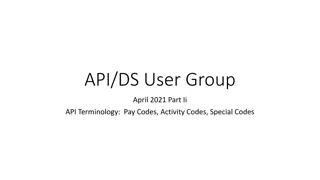Understanding the Impact of New BEE Codes on Business in 2014
Explore the framework and structure of the new BEE codes introduced in 2014, delving into how these regulations affect various aspects of businesses. Learn about measuring ownership, socio-economic development, management control, and more. Discover the economic impact of BBBEE and gain insights into the business model environment influenced by regulatory, technological, and societal trends.
Download Presentation

Please find below an Image/Link to download the presentation.
The content on the website is provided AS IS for your information and personal use only. It may not be sold, licensed, or shared on other websites without obtaining consent from the author. Download presentation by click this link. If you encounter any issues during the download, it is possible that the publisher has removed the file from their server.
E N D
Presentation Transcript
New BEE Codes 2014 How will the new codes impact your business?
Programme 01 Overview > Structure of The New Codes Framework used to understand the Business Impact of the New Codes 02 Discussion > Business Impact of the New Codes 03 Dialogue > 04 Presentation > Understanding the New Codes through Decision Trees 05 Demo > BEE Calculators, based on the New Codes Facilitated Process Articulating the Challenges presented by the New Codes Developing a Work Plan to deal with identified Challenges 06 >
Structure of the New Codes Statement 100: The General Principles For Measuring Ownership Statement 500: Statement 200: Statement 000: The General Principles For Measuring Socio- Economic Development The General Principles For Measuring Management Control General Principles And The Generic Scorecard Statement 400: Statement 300: The General Principles For Measuring Enterprise And Supplier Development The General Principles For Measuring Skills Development
Framework used to understand the Business Impact of the New Codes
Economic Impact of BBBEE Figure adapted from CRACKING BROAD-BASED BEE, by Tony Balshaw & Jonathan Goldberg Government and Public Sector Entities Sale of a state asset or SOE Public- Private Partnership Concessions Authorisations Licenses Tenders Incentives First-tier Enterprises Private Sector suppliers to first-tier Enterprises Cascading to all tiers and sectors of the economy
Business Model Environment (Source: Business Model Generation; 2010;Alexander Osterwalder, Yves Pigneur; John Wiley & Sons Inc) - FORESIGHT - REGULATORY TRENDS SOCIETAL AND CULTURAL TRENDS TECHNOLOGY TRENDS KEY SOCIOECONOMIC TRENDS TRENDS SUPPLIERS AND OTHER VALUE CHAIN ACTORS MARKET SEGMENTS STAKEHOLDERS NEEDS AND DEMANDS - MARKET ANAYSIS - - COMPETITIVE ANALYSIS - INDUSTRY FORCES MARKET FORCES MARKET ISSUES COMPETITORS (INCUMBENTS) SWITCHING COSTS NEW ENTRANTS (INSURGENTS) REVENUE ATTRACTIVENESS SUBSTITUTE PRODUCTS AND SERVICES MACRO- ECONOMIC FORCES ECONOMIC INFRASTRUCTURE GLOBAL MARKET CONDITIONS COMMODITIES AND OTHER RESOURCES CAPITAL MARKETS - MACROECONOMICS -
Business Model Canvas Business Model Canvas (Based on the book Business Model Generation; Alexander Osterwalder & Yves Pigneur;2010) The Key Activities Building Block describes the most important things a company must do to make its business model work The Key Partnerships Building Block describes the network of suppliers and partners that make the business model work The Value Propositions Building Block describes the bundle of products and services that create value for a specific Customer Segment The Customer Relationships Building Block describes the types of relationships a company establishes with specific Customer Segments The Customer Segments Building Block defines the different groups of people or organisations an enterprise aims to reach and serve The Channels Building Block describes how a company communicates with and reaches its Customer Segments to deliver a Value Proposition The Key Resources Building Block describes the most important assets required to make a business model work The Cost Structure describes all costs incurred to operate a business model The Revenue Streams Building Block represents the cash a company generates from each Customer Segment
Business Model Environment (Source: Business Model Generation; 2010;Alexander Osterwalder, Yves Pigneur; John Wiley & Sons Inc) - FORESIGHT - REGULATORY TRENDS SOCIETAL AND CULTURAL TRENDS TECHNOLOGY TRENDS KEY SOCIOECONOMIC TRENDS TRENDS SUPPLIERS AND OTHER VALUE CHAIN ACTORS MARKET SEGMENTS STAKEHOLDERS NEEDS AND DEMANDS - MARKET ANAYSIS - - COMPETITIVE ANALYSIS - INDUSTRY FORCES MARKET FORCES MARKET ISSUES COMPETITORS (INCUMBENTS) SWITCHING COSTS NEW ENTRANTS (INSURGENTS) REVENUE ATTRACTIVENESS SUBSTITUTE PRODUCTS AND SERVICES MACRO- ECONOMIC FORCES ECONOMIC INFRASTRUCTURE GLOBAL MARKET CONDITIONS COMMODITIES AND OTHER RESOURCES CAPITAL MARKETS - MACROECONOMICS -
Regulatory Trends The following entities are measurable under the Codes: a) All Organs of State and Public Entities b) All Measured Entities that undertake economic activity with all Organs of State and Public Entities c) Any other Measured Entity that undertakes any economic activity, whether direct or indirect, with any other Measured Entity that is subject to measurement under (a) to (b) and which is seeking to establish its own B- BBEE compliance NB:Measured Entities in sectors where there are Sector Codes are excluded (i.e. they can only be measured in accordance with their respective Sector Codes)
Business Models of Companies using the Generic Codes National Government Suppliers governed by the Generic Codes Provincial Government Local Government Public Private Partnerships (PPPs) Licenses Parastatals Concessions Other authorisations in terms of any law
Business Models of Companies using Sector Codes Suppliers governed by the Generic Codes
Business Models of Companies doing business with entities that undertake economic activity with Organs of State and Public Entities Private Sector Sales to companies that undertake economic activity with Organs of State and Public Entities
Given this, what should we be doing during the Transitional Period? Business Strategy/BEE Strategy Monitoring & Evaluation Systems Business Processes Policies Review
Structure of the New Codes Statement 100: The General Principles For Measuring Ownership Statement 500: Statement 200: Statement 000: The General Principles For Measuring Socio- Economic Development The General Principles For Measuring Management Control General Principles And The Generic Scorecard Statement 400: Statement 300: The General Principles For Measuring Enterprise And Supplier Development The General Principles For Measuring Skills Development
Statement 000 General Principles And The Generic Scorecard
Do the Codes apply to my Organisation? The Codes do apply to your Organisation The Codes do apply to your Organisation The Codes do apply to your Organisation Yes Yes Yes Does my Organisation undertake any economic activity with an Organ of State or Public Entity? Does my Organisation undertake any economic activity (direct or indirect) with an Organisation that undertakes any economic activity with an Organ of State or Public Entity? Is my No No Organisation an Organ of State or Public Entity? No The Codes do not apply to your Organisation
Types of Enterprises The Codes specify the following types of Enterprises: Large Enterprises Qualifying Small Enterprises Exempted Micro Enterprises and Start-up Enterprises
To which category of Enterprises does my Organisation belong? Large Enterprise >= R 50 million Unknown (Start-up) > R 10 million < R50 million What is my Organisation s Annual Total Revenue? Qualifying Small Enterprise Start-up Enterprise <= R 10 million Exempted Micro Enterprise NB: Revenue Thresholds used to determine enterprise categories have been increased
The B-BBEE Generic Scorecard Element Weighting Code Series Reference Ownership 25 points 100 Management Control 19 points 200 Skills Development 20 points 300 Enterprise and Supplier Development 40 points 400 Socio-Economic Development 5 points 500 Maximum Possible Standard Points = 109
How do I know what my Organisations B-BBEE Status is? What is my Organisation s B-BBEE Recognition Level? Your Organisation s B-BBEE Status is Level One Contributor Your Organisation s B-BBEE Recognition Level is 135% >= 100 Your Organisation s B-BBEE Recognition Level is 125% Your Organisation s B-BBEE Status is Level Two Contributor >= 95 < 100 Your Organisation s B-BBEE Recognition Level is 110% Your Organisation s B-BBEE Status is Level Three Contributor >= 90 < 95 Your Organisation s B-BBEE Status is Level Four Contributor Your Organisation s B-BBEE Recognition Level is 100% >= 80 < 90 How many points did my Organisation obtain? Your Organisation s B-BBEE Status is Level Five Contributor Your Organisation s B-BBEE Recognition Level is 80% >= 75 < 80 Your Organisation s B-BBEE Recognition Level is 60% Your Organisation s B-BBEE Status is Level Six Contributor >= 70 < 75 Your Organisation s B-BBEE Status is Level Seven Contributor Your Organisation s B-BBEE Recognition Level is 50% >= 55 < 70 Your Organisation s B-BBEE Status is Level Eight Contributor Your Organisation s B-BBEE Recognition Level is 10% >= 40 < 55 Your Organisation s B-BBEE Status is Non-Compliant Contributor Your Organisation s B-BBEE Recognition Level is 0% < 40 NB: B-BBEE Status range limits have been increased for each Level
Under what circumstances can an Organisations B-BBEE Status be Enhanced? No Yes Is the EME at least 51% Black owned? Enhanced B-BBEE Status of Level Two Contributor Deemed B-BBEE Status of Level Four Contributor No Yes Yes Is the Enhanced B-BBEE Status of Level One Contributor Is the EME 100% Black owned? Organisation an EME? No Yes Yes Enhanced B-BBEE Status of Level One Contributor Is the Is the QSE 100% Black owned? Organisation a QSE? No No Yes No Is the QSE at least 51% Black owned? Enhanced B-BBEE Status of Level Two Contributor Verified B-BBEE Status NB: B-BBEE Status enhancement basis has changed for EMEs & QSEs
Sub-minimum requirements for Priority Elements Priority Element Sub-minimum Ownership 40% of Net Value (40% of the 8 points) based on the Time Based Graduation Factor Skills Development 40% of the total weighting points for Skills Development Enterprise and Supplier Development 40% for each of the three categories, within the Enterprise and Supplier Development element, namely Preferential Procurement, Supplier Development & Enterprise Development NB: Inability to achieve the sub-minimums for priority elements may result in an Organisation s B-BBEE Status dropping one level down (Discounting Principle)
Under what circumstances can an Organisations B-BBEE Status be Discounted (Large Enterprises & QSEs)? Scenario No. Ownership sub- minimum achieved? Skills Enterprise and Supplier Development sub-minimum achieved? Verdict: Large Enterprises Verdict: QSEs Development sub-minimum achieved? 1 Yes Yes Yes Discounting principle does not apply Discounting principle does not apply 2 Yes Yes No Discounting principle applies Discounting principle does not apply 3 Yes No No Discounting principle applies Discounting principle applies 4 No No No Discounting principle applies Discounting principle applies 5 No No Yes Discounting principle applies Discounting principle applies 6 No Yes Yes Discounting principle applies Discounting principle applies
Statement 100 The General Principles For Measuring Ownership
The Ownership Scorecard Indicator Description Weighting Points Compliance Target Voting Rights Exercisable Voting Rights in the Entity in the hands of Black people 4 25% + 1 Vote Exercisable Voting Rights in the Entity in the hands of Black women 2 10% Economic Interest Economic Interest in the Entity to which Black people are entitled 4 25% Economic Interest in the Entity to which Black women are entitled 2 10% Economic Interest of any of the following Black natural people in the Measured Entity: Black designated groups; Black participants in Employee Share Ownership Programmes; Black people in Broad-based Ownership Schemes; Black participants in Co- operatives 3 3% New Entrants 2 2% Realisation Points Net Value 8 Anchored on Time-Based Graduation Factor of the Economic Interest Compliance Target
Statement 200 The General Principles For Measuring Management Control
Management Control Scorecard Measurement Category Criteria Weighting Points Compliance Targets Board Participation Exercisable voting rights of black board members as a percentage of all board members 2 50% Exercisable voting rights of black female board members as a percentage of all board members 1 25% Black Executive directors as a percentage of all executive directors 2 50% Black female Executive directors as a percentage of all executive directors 1 25% Other Executive Management Black Executive Management as a percentage of all executive management 2 60% Black female Executive Management as a percentage of all executive management 1 30% Senior Management Black employees in Senior Management as a percentage of all Senior Management 2 60% Black female employees in Senior Management as a percentage of all Senior Management 1 30% Middle Management Black employees in Middle Management as a percentage of all middle management 2 75% Black female employees in Middle Management as a percentage of all middle management 1 38% Junior Management Black employees in Junior Management as a percentage of all junior management 1 88% Black female employees in Junior Management as a percentage of all junior management 1 44% Employees with disabilities Black employees with disabilities as a percentage of all employees 2 2%
Statement 300 The General Principles For Measuring Skills Development
The Skills Development Scorecard Category Skills Development Element Weighting Points Compliance Target Skills Development Expenditure on any programme specified in the Learning Programme Matrix for black people as a percentage of the Leviable Amount Skills Development Expenditure on Learning Programmes specified in the Learning Programme Matrix for black people as a percentage of Leviable Amount 8 6% Skills Development Expenditure on Learning Programmes specified in the Learning Programme Matrix for black employees with disabilities as a percentage of Leviable Amount 4 0.3% Learnerships, Apprenticeships, and Internships Number of black people participating in Leanerships, Apprenticeships and Internships as a percentage of total employees 4 2.5% Number of black unemployed people participating in training specified in the Learning Programme Matrix as a percentage of number of employees 4 2.5% Bonus points Number of black people absorbed by the Measured and Industry Entity at the end of the Learnership programme 5 100%
Statement 400 The General Principles For Measuring Enterprise And Supplier Development
Enterprise and Supplier Development Scorecard Category Criteria Weighting Points Compliance Targets Preferential Procurement B-BBEE Procurement Spend from all Empowering Suppliers based on the B-BBEE Procurement Recognition Levels as a percentage of Total Measured Procurement Spend 5 80% B-BBEE Procurement Spend from all Empowering Suppliers that are Qualifying Small Enterprises based on the applicable B-BBEE Procurement Recognition Levels as a percentage of Total Measured Procurement Spend 3 15% B-BBEE Procurement Spend from all Exempted Micro-Enterprises based on the applicable B- BBEE Procurement Recognition Levels as a percentage of Total Measured Procurement Spend 4 15% B-BBEE Procurement Spend from Empowering Suppliers that are at least 51% black owned based on the applicable B-BBEE Procurement Recognition Levels as a percentage of Total Measured Procurement Spend 9 40% B-BBEE Procurement Spend from Empowering Suppliers that are at least 30% black women owned based on the applicable B-BBEE Procurement Recognition Levels as a percentage of Total Measured Procurement Spend 4 12% Bonus points: B-BBEE Procurement Spend from Designated Group Suppliers that are at least 51% Black owned 2 2% Supplier Development Annual value of all Supplier Development Contributions made by the Measured Entity as a percentage of the target 10 2 % of NPAT Enterprise Development Annual value of Enterprise Development Contributions and Sector Specific Programmes made by the Measured Entity as a percentage of the target 5 1% of NPAT Bonus Points Bonus point for graduation of one or more Enterprise Development beneficiaries to graduate to the Supplier Development level 1 Bonus point for creating one or more jobs directly as a result of Supplier Development and Enterprise Development initiatives by the Measured Entity 1
Definition Empowering Supplier should meet at least 3 if it a large enterprise or 1 if it a QSE of the following criteria: a) At least 25% of the cost of sales excluding labour cost and depreciation must be procured from local producers or local supplier in SA, for service industry labour cost are included but capped to 15% b) Job creation - 50% of jobs created are for Black people provided that the number of Black employees since the immediate prior verified B-BBEE Measurement is maintained c) At least 25% transformation of raw material/beneficiation which include local manufacturing, production and /or assembly, and/or packaging d) Skills transfer at least spend 12 days per annum of productivity deployed in assisting Black EMEs and QSEs beneficiaries to increase their operation or financial capacity
Statement 500 The General Principles for Measuring Socio-Economic Development
The Socio-Economic Development Scorecard Criteria Weighting Points Compliance Target Annual value of all Socio-Economic Development Contributions by the Measured Entity as a percentage of the target 5 1% of NPAT
Summary Measured Entities in sectors where there are Sector Codes are excluded (i.e. they can only be measured in accordance with their respective Sector Codes) Revenue Thresholds used to determine enterprise categories (Large enterprise, QSE, EME, etc) have been increased B-BBEE Status range limits have been increased for each Level B-BBEE Status enhancement basis has changed for EMEs & QSEs. These enterprises can now be promoted to a Level 1 or 2 depending on whether they are 100% black owned or 51% black owned Inability to achieve the sub-minimums for priority elements (Ownership, Skills Development & Enterprise and Supplier Development) may result in an Organisation s B-BBEE Status dropping one level down (Discounting Principle) The requirement for an Empowering Supplier has been introduced in the Preferential Procurement component of the Enterprise and Supplier Development Scorecard Companies must understand which aspects of their Business Model are impacted by the New Codes
Challenges in implementing the New Codes Accelerators what is already being done or can be done to support the implementation of the New Codes? Brakes what stands in the way of the implementation of the New Codes?
Work Plan to deal with Challenges What needs to be done, to work towards the successful implementation of the New Codes?























